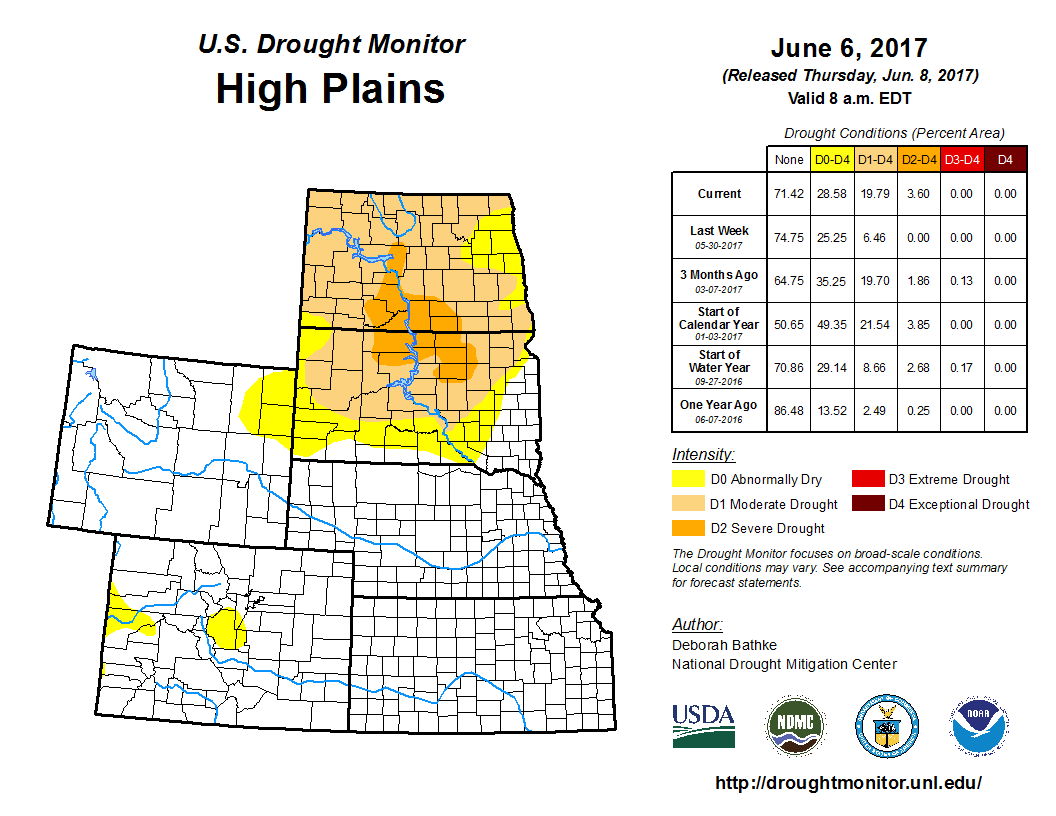South Dakota is Feeling the Heat
One thing that leaps out of USDA’s Crop Progress report for the week ended June 11 is problems in South Dakota, No. 6 in the nation for 5.4 million planned corn acres. Planting was completed and 98 percent of the corn has emerged, four points ahead of South Dakota’s five-year average and ahead of the 18-state level.
However, the South Dakota corn crop is rated only 45 percent good/excellent, while the 18 states as a whole are rated 67 percent good/average, down one point from the prior week and seven points behind last year.
On the poor/very poor end of the scale, South Dakota stands at 18 percent, compared with only 8 percent for the 18 states.
In contrast, Iowa is rated 77 percent good/excellent, and Nebraska, 78 percent. Kansas stands at 65 percent. Nebraska’s poor/very poor rating is only 2 percent; Iowa, 4 percent; and Kansas, 7 percent.
Soybean planting ahead of average
USDA reports planting 92 percent complete in the 18 states, compared with 87 percent on average. Iowa and Kansas are eight points ahead of average, at 98 percent and 80 percent respectively. South Dakota, at 99 percent, is six points ahead and, at 97 percent finished, Nebraska is one point ahead of average.
At 77 percent, emergence also is ahead of normal – by four points for the 18 states. South Dakota is 13 points above average; Kansas, eight points; Iowa, six points; and Nebraska, two points.
As was the case with corn, South Dakota lags the 18-state soybean ratings: Its top-end ratings total only 43 percent – the lowest of the reported states. Its bottom-end ratings total 15 percent, the highest of the 18 states. The 18-states’ overall crop rating is 66 percent good/excellent and 6 percent poor. Nebraska’s soybean crop is 74 percent good/excellent and 2 percent poor/very poor; Iowa, 69 percent and 4 percent; and Kansas 60 percent and 2 percent.
Grain Sorghum
In the 11 states USDA includes in its report, grain sorghum planting is two points behind average, at 71 percent. However, South Dakota farmers are 87 percent finished, compared with an average of 76 percent. Kansas planting stands at 52 percent, eight points behind average.
Sorghum condition is rated 69 percent good/excellent and just 2 percent poor/very poor for the 11 states. This crop in South Dakota also looks worse than the other states, with only 14 percent good and zero excellent, while 33 percent is rated poor/very poor.
Wheat
With all of its spring wheat emerged, South Dakota’s good/excellent ratings are only 13 percent, against 45 percent for the six states that accounted for 99 percent of 2016 acreage. A hefty 57 percent falls in the poor/very poor end of the range, compared with 20 percent for all states.
Winter wheat heading is close to its average, with only the most northern states having about 30 percent still to go. Harvest is underway in the South and stands at 17 percent, compared with 15 percent on average.
Winter wheat condition is rated 50 percent good/excellent and 16 percent poor/very poor. While not much changed from the prior week, this is well behind last year’s 61 percent on the top end and 9 percent on the bottom end.
The Kansas crop rating hasn’t changed much: 24 percent poor/very poor and 45 percent good/excellent, while Nebraska’s crop is rated 13 percent on the bottom end and 51 percent on the top end.
Behind South Dakota’s woes
One doesn’t have to look far to see the reason for problems in South Dakota. As the June 6 Palmer Drought Severity Index map shows, its north-central counties are experiencing severe drought (orange), while more than half the state is in moderate drought (tan) and the southern and western areas (yellow) are abnormally dry. Virtually all of the Corn Belt is free of dryness concerns.
 The next four to six weeks are the makers or breakers for corn yields. We’ve already seen some volatility on wet weather and conjecture about replant and prevent-plant acres – which won’t be known for some time, though USDA’s June acreage report may provide some insight.
The next four to six weeks are the makers or breakers for corn yields. We’ve already seen some volatility on wet weather and conjecture about replant and prevent-plant acres – which won’t be known for some time, though USDA’s June acreage report may provide some insight.
Analysis on the farmdoc.edu website by Economist David Widmar of prevented acreage the past 10 years concludes that even the lowest number pf prevented acres (equivalent to 1.6 bu./acre nationally), applied to 2016 supply/demand, would have had an impact on stocks/use, dropping it from 16.6 percent to 15.7 percent. The highest percent prevented (equal to a 5.2 bu./acre drop in national yield) would have dropped the ratio all the way to 12.6 percent.
So, while we still have ample supplies on hand, traders’ reactions to weather worries still could produce modest price bounces.

